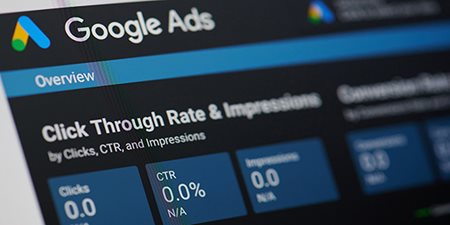Google’s Updates to Metrics for Digital Marketing
Another year, another algorithm. Almost every year, and sometimes twice a year, marketers must work with the search giants to change the algorithms and metrics to keep atop of the digital marketing game for your business and their clients. The Google Web Tools is a suite that nearly every marketer uses to research, optimize, and execute digital marketing activities. The changes can be something that impacts significant tactics, such as SEO and SEM, but others may merely affect one of the strategies. Last year, Google Ads finally transitioned all advertisers to its new interface which came with some major changes, specifically, the ‘average position’, which no longer appeared in a column by default. Then, in November, Google Ads moved the column in the “Add Columns” interface from “Performance” to “Competitive Metrics.” While this is buried deep, these moves signaled the demotion of this metric, and now Google has made it official. Google announced—in a very brief announcement post called ‘Prepare for average position to Sunset’—that they’ll eliminate the average position metric in the third quarter of this year. With limited information in their announcement, what does it mean for marketers? Let us break it down for you.
The changes can be something that impacts significant tactics, such as SEO and SEM, but others may merely affect one of the strategies. Last year, Google Ads finally transitioned all advertisers to its new interface which came with some major changes, specifically, the ‘average position’, which no longer appeared in a column by default. Then, in November, Google Ads moved the column in the “Add Columns” interface from “Performance” to “Competitive Metrics.” While this is buried deep, these moves signaled the demotion of this metric, and now Google has made it official. Google announced—in a very brief announcement post called ‘Prepare for average position to Sunset’—that they’ll eliminate the average position metric in the third quarter of this year. With limited information in their announcement, what does it mean for marketers? Let us break it down for you.
Goodbye Average Position and a Little History
Average position was one of the OG metrics in Google Ads when their search advertising product, AdWords, was first launched. Historically, average position was a very useful metric because ads reliably showed up in consistent locations on the page. Understanding the average position of an ad provided marketers the information to know where your ad showed on a web page, thus correlating the success or failure of your ad placement. In the early days of AdWords, premium ads and placements were typically sold to larger companies—who had large budgets—while smaller advertisers were able to advertise on the right side as well—usually lower down—as they were paid on a CPC basis. Thus, if you were a large business and your ad was reported as an average position of number one, you knew you were the first ad showing on the right side of the search engine result pages (SERP). But like most launched services, they evolved, and so did Google. Ads that were in premium locations on the page from businesses who were paying on a CPM basis were making less money than the CPC ads on the right side; thus, the merge happened, making all businesses compete for ad placement based on Ad Rank (CPC bid + CTR). This push towards Ad Rank meant the ads with the highest rank would only be shown above the organic results if they met a certain relevancy threshold; a user-focused strategy Google implemented to ensure users would see just the most effective ads. In this case, your ad was reported as being in position number one, and that was a certainty, but what was not certain was where it showed. This marked the end of the effectiveness and meaning of ‘average position’.
Further changes such as ads completely disappearing from the right side, all ads placed at the top of the page, different thresholds and auction rules, and new ad platforms and formats (i.e., shopping), resulted in search advertising to evolve significantly. While average position continued to reflect an ad rank, it was becoming less and less clear to what it equated. Furthermore, what used to be an OG / primary metric for optimization and very useful for analytics and reporting, is now gone.
You Say Goodbye, But I Say Hello
Welcome, prominence metrics! As the average position sunsets, four prominence metrics are among those rising, or rather, risen, since they launched in November.
-
Impression Absolute Top %: This metric is the percentage of time your ads are in the very first position, above the organic search results.
-
Impression Top %: This metric is the percentage of the time your ads are anywhere above the organic search results.
-
Search Absolute Top (IS): This metric is the result of taking the number of impressions you’ve received in the absolute top location (the very first ad above the organic search results), divided by the estimated number of impressions you were eligible to receive in the top location.
-
Search Top (IS): This metric is the result of reviewing the impressions received in the top location (anywhere above the organic search results), compared to the estimated number of impressions you were eligible to receive in the top location.
And You May Ask Yourself, “Well, How Did We Get Here?”
So, why the change? We just got accustomed to the new metrics and optimizing of our campaigns. Upon research, the community has identified two main reasons for Google’s changes:
-
Google’s desire for businesses and advertisers to stop thinking of describing where their ads show on the SERP.
-
Google’s desire for more businesses and advertisers to move away from manual bidding.
With these changes and the introduction of the new prominence metrics, the goal is to provide businesses and advertisers more accurate measurement of the reach of campaigns’ ads across qualified impressions, as well as a more authentic view of their position in the ad auction.
'Thank U, Next'
Now it’s up to businesses and advertisers to make time to become familiar with the new metrics, and fully understand how they may impact current and future campaigns. Although this adjustment might cause some consternation, the change has the makings to be a positive for businesses and advertisers rather than a negative. Optimistically, what we will see is a natural evolution that will give businesses much more control over their campaigns’ and ads’ actual performance on the search engine results pages.
For marketers, one crucial change likely is the need to look at adjusting the bidding strategies and position metrics. Some marketers used average position as an input to bid management, while others set their CPCs based on their expectation of clicks leading to conversions. Some simply wanted their ads to always be at the top, so they bid as much as was required to keep that number one spot. Nowadays, with the implementation of automated bidding, bid-to-position strategies don’t quite make sense to the modern-day advertiser.
Another impact would be on those who use search advertising for brand awareness or brand advertising. Yes, Google, at heart, is more of a direct response ad platform, and brand advertisers used this platform to go beyond their display or YouTube ads. Hence, their best strategy was to bid to the top of the page as opposed to using the average position metric. The new prominence metrics for brand advertisers, however, will provide far better data to choose the right bidding strategy.
Ending Notes
As stated at the beginning of the article, another year, another algorithm. Change is constant, and I think we can all agree there is never a dull day working in search advertising, or let’s be honest, digital marketing in general. Although Google may have put a crimp your paid advertising style, they strategically made these changes to address the needs of its businesses and advertisers. This change, or re-strategizing, is just in time for a good spring cleaning of your digital marketing strategy.

Lynette Sawyer
Lynette Sawyer is a Web Project Manager for Falcon-Software, a digital web agency founded in 1994. For the last 13-years Lynette has been in various digital capacities and her expertise goes beyond Project Management. Lynette brings experience and knowledge in graphic design, marketing communications, project management, product management and engagement.